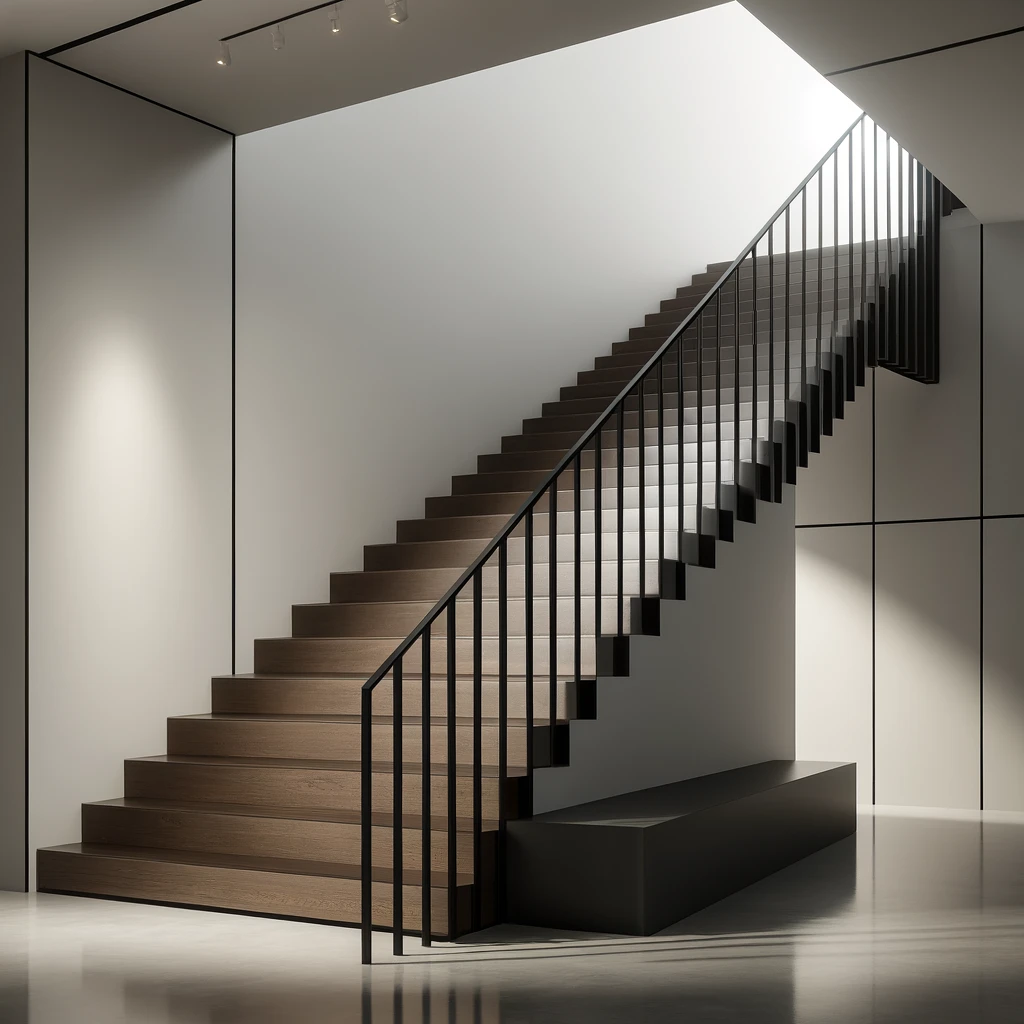Stair Types
- Home
- Information
Stair Types
Straight Stairs
The simplest and most common type, consisting of a straight flight of stairs with no turns.
Straight stairs are simple and practical, with a linear design that makes them space-efficient and easy to navigate. They are accessible and safe when designed with proper dimensions and materials. Straight stairs are cost-effective, customizable, and versatile, fitting well into various architectural styles while serving their functional purpose effectively.


L-Shaped Stairs
Consists of two straight flights of stairs connected by a landing that forms a 90-degree angle.
L-shaped stairs feature two straight flights connected by a 90-degree landing, saving space and allowing for direction changes. They’re popular for maximizing space in homes and offices. Safety measures like handrails and landings enhance safety, while customization options offer aesthetic appeal. Although generally accessible, considerations for mobility-impaired individuals are necessary. Overall, L-shaped stairs combine functionality with space efficiency and design versatility.
U-shaped Stairs
Similar to L-shaped stairs but with a 180-degree turn, often with a landing between the two flights.
U-shaped stairs consist of two parallel flights connected by a landing that makes a 180-degree turn, saving space while adding visual appeal. They can be customized for safety and aesthetics but may pose challenges for those with mobility issues. Despite this, they remain a versatile and popular choice for both residential and commercial spaces.


Spiral Stairs
A compact staircase that spirals around a central pole or column, typically found in tight spaces or as a decorative feature.
Spiral stairs wind around a central pole or column, saving space and adding visual appeal. They come in various designs and materials but may not be ideal for everyone due to safety considerations. Despite this, they remain a popular choice for homes and buildings where a unique staircase design is desired.
Curved Stair
Curved stairs: Similar to spiral stairs but with a more gradual curve, often used in grand or spacious settings.
Curved stairs are prized for their elegance and sophistication, featuring a sweeping curve along their length. They offer design flexibility, allowing customization in curve radius, materials, and handrail styles. While they may require more space and investment, they create a dramatic architectural statement in upscale settings. However, their installation demands attention to safety and accessibility considerations, making them a popular choice for visually striking staircases in grand designs.


Floating Stairs
Also known as cantilevered stairs, these stairs appear to “float” without the support of risers, creating a modern and open look.
Floating stairs, also known as cantilevered stairs, create a modern and minimalist look by appearing to float without visible support. They’re popular for contemporary interiors due to their space-saving design and sleek appearance. However, they require careful installation for structural stability and safety, including the addition of handrails. While visually striking, they can be more complex and costly to install compared to traditional stairs.
Helical Stairs
Similar to spiral stairs but with a more gentle curve, often seen in circular staircases in grand buildings.
Helical stairs feature a continuous spiral curve, adding elegance and sophistication to interiors. While they may occupy more floor space, they efficiently facilitate vertical movement. Their customizable design options and aesthetic appeal make them popular, although their installation complexity and cost are higher. Safety measures like sturdy handrails are essential, and accessibility considerations are important for user comfort and usability. Despite these challenges, helical stairs remain a favored choice for upscale spaces due to their visual impact and design versatility.


Bifurcated Stairs
A grand staircase that splits into two branches, often at a landing, creating a symmetrical look.
Bifurcated stairs are grand and symmetrical, splitting into two branches usually at a landing. They add sophistication and elegance to large buildings and luxurious homes, although they require more space and investment than simpler designs. Customizable and visually striking, they require careful safety considerations and skilled craftsmanship during installation. Despite potential challenges for those with mobility issues, bifurcated stairs remain a captivating architectural feature.
Scissor Stairs
Two flights of stairs that meet at a landing and are angled in opposite directions, resembling an open pair of scissors.
Scissor stairs are a space-efficient design with two flights changing direction at a landing, forming an “X” shape. They save space and can enhance aesthetics but require careful design and construction for safety and accessibility. Despite being more complex and costly, they offer a practical solution for limited spaces with skilled installation.








